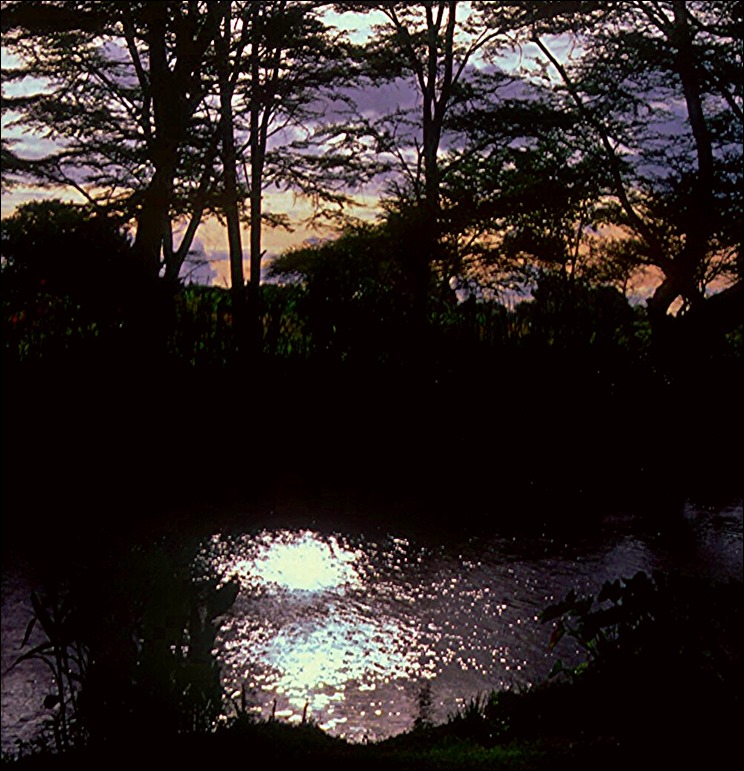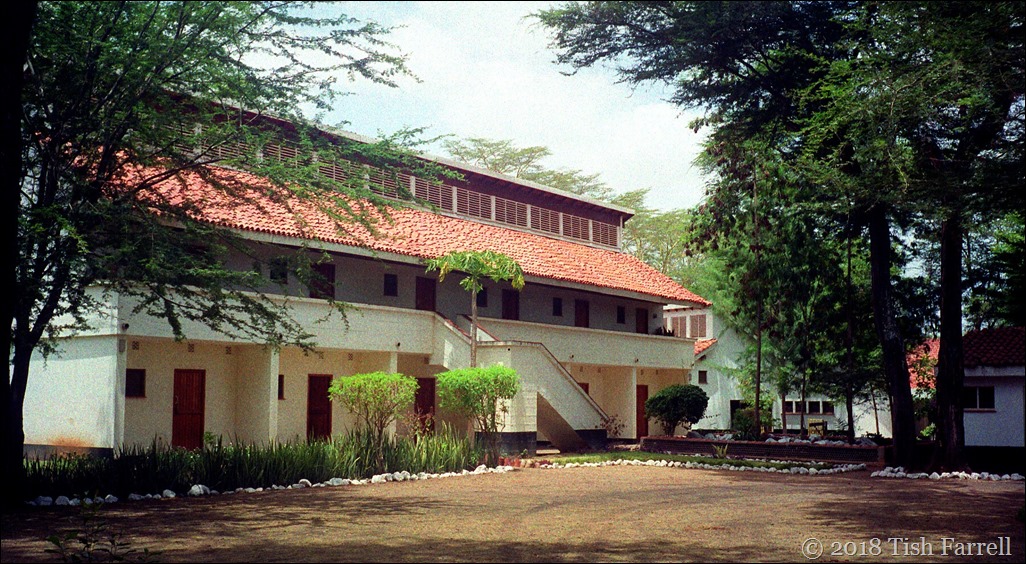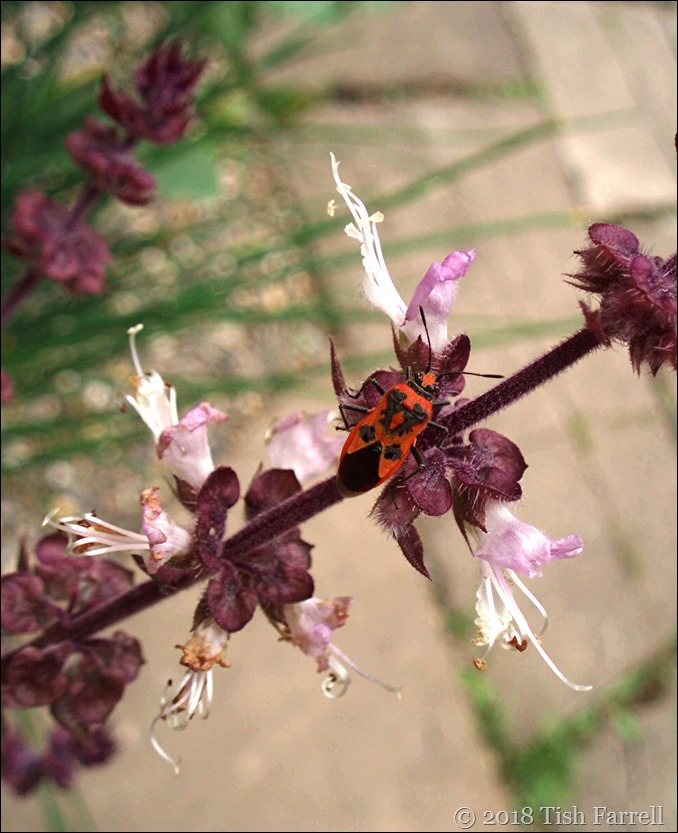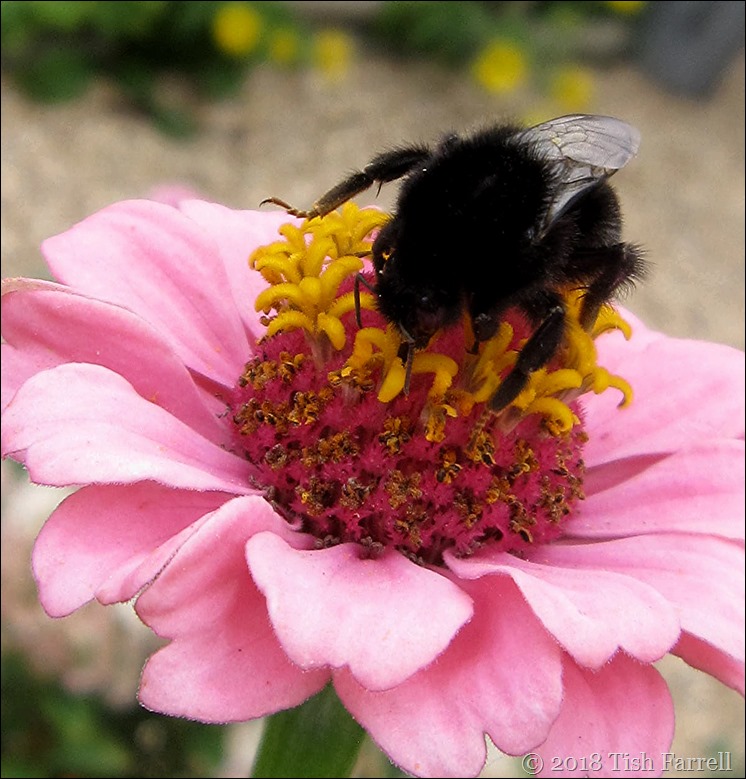
When I ran away to Africa in February 1992, Hunter’s Lodge at Kiboko was the first place Graham took me to. Then it was a run-down safari lodge, developed in the 1960s-70s from the erstwhile home of great white hunter, John Hunter. We were told the place had had its heyday back then. Asian and expatriate European families would drive out from Nairobi to spend the weekend there and also, before the nearby highway was paved, it was a very welcome place to break the red-dusty, hour-on-hour, gut-wrenching drive from Nairobi to the Mombasa coast.
In the time we spent there – and it was pretty much our second home during that year, and again at the end of 1993 (the Kiboko field station where Graham’s team of Kenyan researchers were monitoring methods of Larger Grain Borer control was just next door) – we were always surprised if we arrived at the Lodge to find someone else staying there.

To me it seemed like an oasis, and indeed John Hunter had meant to be one. He had once known the spot as a popular elephants’ watering hole on the Kiboko River, and so had decided to dam the watercourse to create a small lake to attract bird life. This was the place he had chosen to end his days after a life’s-work of ivory hunting, celebrity safari running, and game control work for the colonial game department.
He was a speak-his-mind Scotsman who had been among the earliest arrivals of white settlers in what was then the British East Africa Protectorate (later Kenya Colony). In the 1920s and ‘30s he hunted with the likes of Denys Finch Hatton and Bror Blixen who considered him an elder statesman in all matters of stalking and bush-craft. On his own admission, he had cleared the Kiboko-Makindu location of over 1,000 rhino. He had also helped rid the area of its elephant population – this to protect colonial sisal and orange plantations and the farm plots of the local Akamba people in the native reserve further north. In his day, the colonial ambition was to develop the agricultural potential of East Africa to help pay for the very expensive railway the British government had built from Mombasa to Lake Victoria (built 1895-1901). Ideas about game conservation did not begin to take hold until 1948, and even then some colonial administrators were still likely to see Kenya as their personal hunting ground.
Hunter’s Lodge, then, was a place of many resonances, currents and undercurrents, many I only unravelled later; am still unravelling.

Our day there began with breakfast at 7 am in the dining room with the surprising ‘ogival’? doors front and back, presumably part of the original Hunter home. By that time the weaver birds in their papyrus clumps were at full chirp, the storks in their fever tree roosts honking and bill clattering, the pied kingfishers taking up diving positions. By then, too, the vervet monkeys would be eyeing up their options: our veranda door carelessly left ajar, the possibility of later pickings in our room should access prove feasible?
In the dining room where we rarely saw anyone but Reuben, the old Akamba waiter, who unfailingly asked us if we would have eggs with our breakfast. We never did, and only realised very much later that every day we had stayed there, we had been charged for a full three course English breakfast. Usually we had wheat flakes with milk that had been boiled. We learned to take a plastic tea strainer with us to sieve out the skin. The milk was delivered by local Maasai women, who would arrive at the kitchen door in all their red and beaded regalia. The tea always had a sulphurous taste from the local spring water. The boiled milk didn’t help much.

Graham left for work at 7.30 and for the next five hours till he returned for lunch (chips or cheese sandwiches) I wrote, read, wandered the garden, and watched. Time there was like a waking reverie, a guided meditation, never being anywhere but ‘in the moment’. Since few guests came, the hotel staff had a routine that did not involve providing hospitality. I watched the daily comings and goings of the garden workers – the sweeping, mowing, the tending of the vegetable shamba. I’d hear the bell that summoned all the staff to their tea-break, leaving no one at all around.


Sometimes I chatted with Joyce the chambermaid. I also watched the goings-on at the bungalow across the pool, said to be the home of a local politician. And I learned to identify many local birds. There were said to be over 200 species in the vicinity. One day a lone pelican dropped in. That was a surprise. Sometimes the giant kingfisher would perch on the thorn tree by our room. Then there were the tiny malachite kingfishers – brilliant little jewels of birds. The greyhooded kingfisher was the one I saw most often.

Around 5.30 Graham would return from work, and we’d go to the pool terrace for tea. At some stage we were usually joined by the Lodge’s disconsolate peacock (its mate had been eaten by a python). The bird invariably tried to eat the sugar. Later we would return to the terrace for supper – Tusker beer, steak and chips. There was never much choice. If we were lucky, John the Maasai barman would be on duty. He was always very charming, and always had an awful lot to say on pretty much any topic.

And now here’s an excerpt from the Kenya Diary, written on our return to Kenya after 9 months in Zambia. It includes a far from usual occurrence at Hunter’s Lodge:
20 December 1993
Monday morning and we are off to Kiboko again, out on the dusty Mombasa highway, dodging lorries and potholes, heading for the southern plains. We remark upon the vistas of unaccustomed lushness as we leave Nairobi behind. There have been good rains, and the wooded slopes of upland Ukambani beyond the Machakos turn, are as green as we have ever seen them. And even down on the semi-arid flatlands of low-lying Sultan Hamud and Emali the dark ochre soils seem bloated with wholesome moisture and the promise of a good maize crop.
The locals clearly think so too, for they are out in the fields in force, husbands, wives, grandmothers, children all busy weeding the leafy, foot high seedlings; some guiding a pair of yoked oxen and earthing up the new crop so as to husband every drop of rain, a rich man with a tractor preparing his acres. It is a hive of industry, the bright primary coloured cottons of the women’s kangas and headscarves against the brown and green striking up impressions of carnival optimism.
And for my part I long to thrust my hands into that warm humus-smelling soil and plant out lusty seedlings of courgettes and broad beans, crisp lettuce and cherry tomatoes. I picture a healthy crop of vegetables lying newly plucked in my basket; savour their freshness. But it is only a pipe dream. For it is scarcely so easy, especially here where expected rains may fail and in a few days the hard-nurtured crop be burned to a crisp and blown away with the parched soil. And so as we pass by, we wish them good fortune and good rains, these hard-working hopeful smallholder farmers.
South of Emali the farm fields give way to low thorn scrub. In our previous 1992 trips we had only ever seen it as thickets of thorny shafts and barbs. But now the spikes and spines have burst into luscious greenery, a wrap of verdant baize on every scaly twig, and a delicate flowering of ivory catkins, of golden mimosa pompoms and pink and yellow lanterns that yield a heady scent of orange blossom. From time to time their perfume is drawn in through our open windows and makes a change from the more usual blasts of truck fumes. And amongst all the fresh new greenery, forging its way up through the low trees and shrubs are spires of purple wild flowers and on the open grassland carpets of Parma-violet mauve and forget-me-not blue.
It is just past midday and overhead the sky is as perfect as the glaze on eggshell china. The sun burns. Our journey takes less than two hours, even with all the trucks, but when we turn off the highway at the Akamba woodcarvers stalls at Kiboko and negotiate the roughly made up drive to Hunter’s Lodge, see the low white building with its red pantiled roof and flagstaff standing in the shady garden, there is always a sense of relief, a release of barely held breath. It always seems too like a home-coming, though goodness knows why for there is rarely anyone there to greet us unless Joyce is on duty or John the Maasai is about. Usually we just get the key and tumble into our room with all our belongings and collapse on the brown candlewick-covered bed. Listen to the seamless twittering of golden weavers, the raucous calls of marabou storks and herons way up in the rafters of the fever trees.
We picnic on the veranda. There is so much to watch, the endless high-tension cycle of hunting, prowling, stalking, making a kill, keeping alive, courting, mating, rearing, being hunted – ripples across the pool. After lunch Graham goes off to the field station. I doze within the green cocoon, mesmerised by strands of reflected light until the sun begins to slip through the trees. And suddenly, at the day’s end there is a flurry of heightened purpose amongst the bird-life: swifts, swallows and martins duck and dive over the water in a frenzied pursuit of insects; three bright white and black pied kingfishers fly fast and low over the green surface; the russet speckled giant kingfisher, the size of a young rook and with a beak like a pile driver, plummets from a nearby acacia into the pool, exploding the glare with a mighty crash; there is a flight past of sacred ibis; the eerie hkaa, hkaa hkaa-ing of their cousins the hadadas; and in the fading light a tiny crimson-bibbed and azure helmeted sunbird pierces the trumpet flowers of the thevetia and sips up the nectar concealed within.
All afternoon, across the pool, the local fundi has been working on the new summerhouse in the garden of the Akamba politician’s bungalow. It is octagonal, open-sided with a low wall and a conical tiled roof supported on slender round columns. It will be lovely when it is done. Other men have been cutting the grass with pangas; their hearts were not in it though and they made small progress, but than what is the hurry? The sun is hot, there is always tomorrow and anyway the owner of the house rarely comes. There is a diversion too. Five Maasai women call round to speak with one of the men; all with shaved heads, all shoulders draped in red cotton shawls of identical shade. They lay down their heavy loads at the garden gate, plastic bottles of water, which they have been carrying on slender backs supported by a leather head-strap. They stop for a while chatting, a cluster of exotic birds, then take up their burdens once more and set off in single file along the track that skirts the garden and strikes out into the bush.
Meanwhile I sit in my own private box, watching the pageant unfold, watching as the setting sun casts a low glow through the (earlier) shadowy recesses of the acacia wood so that it takes on all the seeming insubstantial qualities of a back-lit drop from the set of A Midsummer Night’s Dream. But instead of Cobweb and Mustard Seed, a small troop of baboons takes the stage, swings up through the branches, the low light dancing off the coarse hairs of tawny coats. I watch them for a few minutes, while they try to make up their minds whether a raid on the politician’s garden is a viable proposition. Then there is the low rumble of a Land Rover as it comes to rest in the gravel car park below our room. Graham is back. It is time for the interval and a pot of strong Hunter’s Lodge tea out on the terrace by the crook-backed bridge.
21 December
It’s true. I’ve seen it. There really is a crocodile in the Hunter’s Lodge pool; a touch of melodrama and a real-life villain for the piece. Peter Giles (Graham’s former boss) thought he had spotted one, but no one really believed him.
I was busy writing a letter, out on the veranda. Beyond its shade the lawn and pool were full-lit by afternoon sun. It was hot and sultry out there and I was glad of the breeze that funnelled through the open stable doors of our room and out to where I was sitting.
Suddenly there was a commotion of weaver chatter on the branches of the young thorn tree where they were busy building nests. The little tree was right at the water’s edge. I scanned it for incident. Nothing unusual there, but there was in the pool below it. Just off the clipped lawn and heading in an easterly direction cruised the snout, head and shoulders of a partially submerged crocodile. Not massive by any means but perhaps a good four feet long. My heart pounded with thrill of it as I rushed and fumbled for the camera. It had taken me eighteen months to finally convince Graham of the existence of the giant kingfisher, and only then by showing him the beast in action; he was hardly going to believe in the reptile sighting without some sort of proof. I hurried out of our room, down the open staircase, past a chambermaid occupied with the task of sweeping up the unremitting cascade of leaf and twig from the acacias. Round the end of the building where the remnant fairway sign announces ‘hole number 3, 43 yards’, across the sloping turfy lawn (more cautiously now) and down to the water’s edge, camera at the ready.
But there was not a sign of him. Completely disappeared. I patrolled the lawn edge, walked round to the terrace and stood out on the crooked bridge for several minutes and scanned the waters with binoculars. He had gone, submerged, made wary perhaps by the sudden rash of visitors who were now laughing and shouting out in the gardens. I returned to my veranda and was so engrossed in seeking out the disappearing crocodile that I did not at first notice the vervet monkey who had crept into the bedroom over the stable door. But I caught sight of him on his way out. He was making off with half a loaf (tomorrow’s lunch) tucked under his arm. And just to add insult to injury, it turned out that the wretched little creature did not even really like bread. A few minutes later I saw it abandoned, impaled on a branch of the acacia tree outside the veranda.
But more surprising than any of this, when Graham arrived back and I told of the crocodile, he was almost as excited as I was; took no convincing at all. When I tackled him over the gross inconsistency of his confidences in my wildlife sightings he told me that of course he believed in the existence of the crocodile; after all it was a corroborative second sighting, wasn’t it? But what about the giant kingfisher, I asked, ruffled. Oh that’s quite different, says he; only you had seen it! I refrain from biting his ankles and we repair to the terrace for afternoon tea.
Later, after dark we return there for a glass of Kenyan beer. We sit in the dim spotlight of a single lamp strung up in the thorn tree. We hear the cackle of bush babies away in the gloom. The fireflies wink on their course across the pool. A rangy cat trots nervously through a pool of light and disappears across the lawn. The young bow-tied barman sorts through his receipts. A waiter sprawls in a garden chair away in the shadows. There are no other customers. We are happy to be here.

Related: The Way We Were ~ More From The Kenya Diary
Amy at The World Is A Book sets Lens-Artists’ challenge #7: Everyday moments







































![001_thumb[1] 001_thumb[1]](https://tishfarrell.files.wordpress.com/2018/08/001_thumb1_thumb.jpg?w=1026&h=677)































